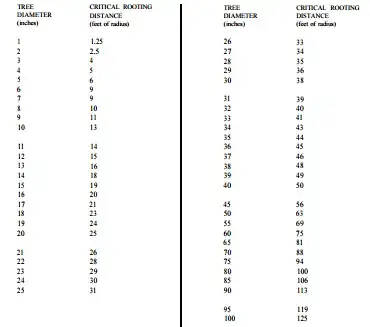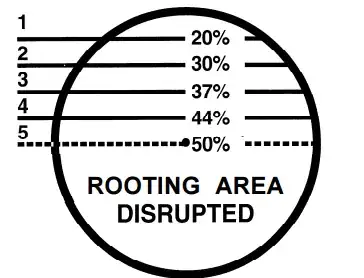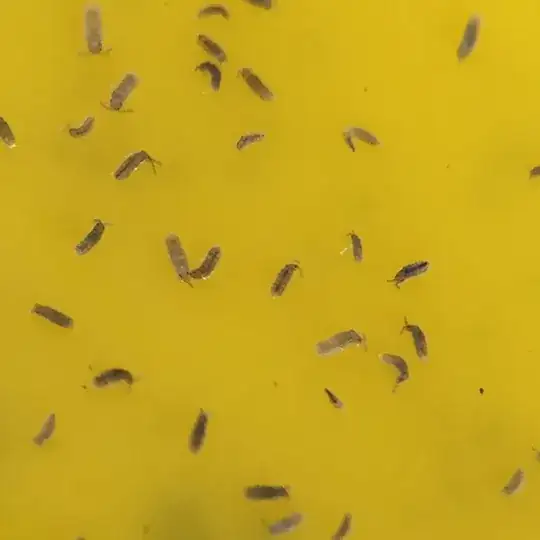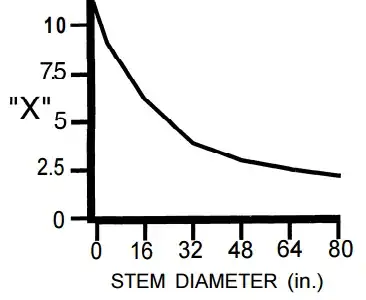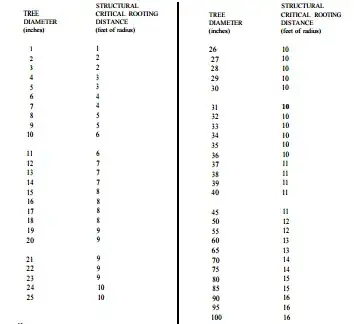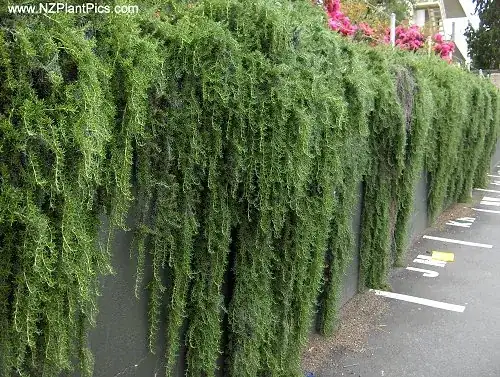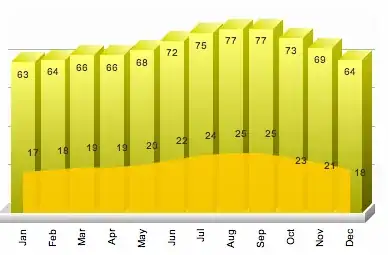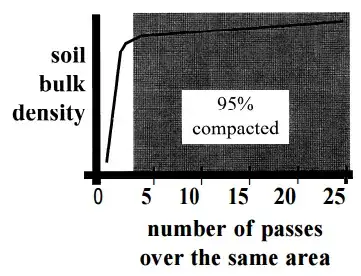This answer will be based on a tool from the University of Georgia Cooperative Extension Service Forest Resources Unit. I have changed it somewhat over the time I've used it, but I was sure to make it as universally applicable as possible, for use over as many species/climates/environments as possible. It's now one of my staple tools, and will be of use to the homeowner as well, for outdoor projects that take place near trees, either DIY or by paid workers.
Introduction
Minimal damage to any plant that has an extensive root system, during a time of soil disruption, crown disruption, has everything to do with prevention. To gain the knowledge of basic prevention principles, one must understand better the root system of a tree.
A key element in assessing developmental impacts on trees located in construction sites is the systematic evaluation of damage. Under the scrutiny of a systematic assessment, these patterned damage forms can be prevented or minimized. Some types of damage (one-time, one-spot, chance occurrences) can be assessed but are difficult to prevent.
This answer will attempt to act as a broad guide, covering in detail the prevention of damage to trees, especially their root zones, in the construction site.
As developmental activities occur on a site, continually monitor damage to tree quality and site resources. Develop a damage class assessment to quantify managerial responses and to project expected tree life-spans and losses. Expected tree reactions to construction damage vary from: immediate and out-right death; single year decline and death; multiple year decline and death; and, decline with major living mass loss. The last two are the most common expectations among residual trees, and the most difficult to prove a cause and effect relationship with construction activities.
As mentioned above, classed damage assessment is key. Below is a guide to classing damage. Note: The damage classing is not necessarily part of the damage prevention system, but is a useful tool to precisely gauge damage. Remember that no assessment tool has the site-specific species-specific knowledge/wisdom that a tree-literate professional observer will be able to offer.
Damage Classing - 8 classes of damage for worksite assessment:
Use this classing system along with the tools (see farther down).
General root system destruction
- A) rooting area loss (surface area and volume) -- TOOL #1, #2, #3
- B) critical rooting distance violations (trenching) -- TOOL #4, #5
- C) open soil surface area loss -- TOOL #6
Root collar and structural support root damage -- TOOL #7, #8
- A) root plate area and the zone of rapid taper (ZRT)
- B) exposed large structural roots>
Mechanical / structural damage to stem -- TOOL #9
- A) chemical or fire damage
- B) wood damage
- C) bark disruption
- D) hardware / signage damage
Soil surface problems (top 12 inches) -- TOOL #10, #11,#12, #13, #14
- A) compaction / fills / cuts / rutting
- B) soil, equipment, or material storage
- C) soil erosion / water availability changes
- D) natural litter loss / soil surface crusting
- E) micro-climate changes
Wind load changes (tree failures under wind loading) -- Note that this
class affects edge or island trees where clearing or thinning has left trees prone to
windthrow. This is the only damage class not necessarily a result of direct mechanical
or soil damage
Major branch damage (number of cuts and heartwood exposure) -- TOOL #15
Health decline (PHC) -- TOOL # 16 & #17
- A) tree damage exposure values and timing
- B) recovery times
Instituting obstructions -- changes in surroundings that will modify growth
success and management activities now and into the future (growing space interference
- new lines, barriers, hardscapes, buildings, trees)
Below is a detailed tool, which I have somewhat changed from the original. Because the text is still largely original to UGA, I will still have it in quote format. I have used this guide for many years, and it is very accurate. There are times when you have to go by feel, but especially for people with less experience, this guide is gold.
Like I said, this is almost entirely related to the root area. That is because the root area is the main area of damage in a worksite, and the area where most people have the most ignorance. There are some parts of the tools that have crown coverage. Just remember that after extensive removal of crown material, the tree is generally best to be removed.
Tools:
These are what you need in prevention, as guidelines for how close to a tree certain activities can be performed, for the maintenance of the tree's health. They can also be used with the damage assessment classing system, above.
1. 920 sq. feet of healthy soil per square foot of tree's cross-sectional area; 2.5 times diameter of tree (inches) = critical rooting distance (feet)<
2. Soil area overlap values per tree based upon site-occupancy values (2.5 X diameter inches) for use where trees share soil space in linear, island, or clump plantings.
number of allowed
equal size area
trees neighboring overlap values
tree A with tree A
2 40%
3 30%
4 20%
5 10%
6 0%
3. Critical rooting distance to minimize tree damage:
Root colonization area and limit of disruption based upon tree diameter at 4.5 feet above the
ground (DBH). Do not trespass or work closer to the tree trunk than the critical rooting distance.
(Table values calculated using 920ft² of biologically healthy soil area per square foot of tree cross-section.
4. Walking toward the tree - percent of rooting area disrupted
5.
6.
7. Root plate radius (in) (stem diameter (in) times "X")
8. Structural Critical Rooting Distance to Minimize Catastrophic Tree Failure. Root plate size (i.e. pedestal roots, zone of rapid taper area, and roots under compression) and
limit of disruption based upon tree diameter at 4.5 feet above the ground (DBH). Significant risk of
catastrophic tree failure exists if structural roots within this given radius are destroyed or severely
damaged
9. Determine and record the following items in the field
Diameter of stem or branch at site of recent injury:
- If the stem / branch area that includes the injury area has little or no taper along its
longitudinal axis then measure the mid-injury diameter of the stem / branch.
(midDIAMETER)
- If the stem / branch area that includes the injury area has significant taper along its
longitudinal axis, from injury top to bottom, then measure the diameter of the stem /
branch at the top and bottom of injury. (topDIAMETER & bottomDIAMETER.)
Dimensions of the new injury:
- Total linear height or length (along longitudinal axis) of injury on stem / branch.
(injuryHEIGHT)**
- Total linear width (perpendicular to longitudinal axis) of injury - not circumference
of injury area. (injuryWIDTH)**
- Depth of injury at deepest point (as best as can be determined or estimated).
(inj uryDEPTH)
Estimate number of annual rings and tissue types breached in the injury.
Location of the injury section in the tree.
Species of tree -- attempt to gauge effectiveness and efficiency of tree reactions to injury.
To determine the DAMAGE ASSESSMENT VALUE for a tree:
- STEP 1A: Determine stem / branch whole segment volume (no taper) =
injuryHEIGHT * 0.785 * (midDIAMETER)²
- STEP 1B: Determine stem / branch whole segment volume (significant taper) =
injuryHEIGHT * 0.262 * (topDIAMETER)² +
0.785 * (bottomDIAMETER)² +
SQUARE ROOT (0.616 * (topDIAMETER)² * (bottomDIAMETER)²).
- STEP 2: Determine injury segment volume (ellipsoidal shape factor) =
0.5 * injuryHEIGHT * injuryWIDTH * injuryDEPTH.
- STEP 3: Determine DAMAGE EXTENT SCORE =
(VOLUME of injury segment (STEP 2) / VOLUME of whole segment (STEP 1)) * 100
Dr. Kim D Coder, 1996
- STEP 4: Determine DAMAGE SEVERITY SCORE. Estimate the number of annual rings
and tissue types breached in an injury.
Select one description that most fully matches the depth of the injury:
- Bark to xylem (score = 0)
- Expanded growing points, one, or two year old xylem (score = 1)
- Three to seven year old xylem - 100% sapwood (score = 2)
- Seven year old xylem to end of sapwood - 100% sapwood (score = 5)
- Heartwood (score = 11)
- Existing damage-modified heartwood and discoloration / decay columns
(score = 23)
- STEP 5: Determine injury location in the tree.
- Root collar / stem base area - two feet out and four feet up (score = 7)
- Root plate area - zone of rapid tapering (ZRT) of pedestal roots or roots that
support the tree under compression - see TOOL #7 & #8 (score = 6)
- Stem base of the live crown (score = 5)
- Stem / trunk (score = 4)
- Injury into reaction wood on basal l/4 of the length of primary scaffold branches -
upper side tension wood in angiosperms / lower side compression wood in nonangiosperms
(score = 3)
- Ground contact / rain splash / direct irrigation wetting area (score = 2)
- South and southwest exposure with full sun (score = 1)
Location numbers l-5 are unique positions and are non-additive (See Figure).
Locations 6 and 7 are additive with other location scores. These scores comprise the
DAMAGE LOCATION SCORE.
- STEP 6:
DAMAGE ASSESSMENT VALUE =
DAMAGE EXTENT SCORE +
DAMAGE SEVERITY SCORE +
DAMAGE LOCATION SCORE
Species and individual tree differences play a critical role in setting management objectives for
an area and acceptance thresholds / tree removal decisions using the DAMAGE ASSESSMENT
VALUE. For long-term tree quality, suggested threshold values for increasing managerial notice
should occur at 15, 22.5, and greater than 30. Removal should be considered at a DAMAGE ASSESSMENT
VALUE of 3 1 and above.
10. Soil Compaction: Soil physical attributes, by soil texture class, where root growth becomes significantly limiting
11. Soil Compaction Values
12. Approximate amount of soil fill, by texture class, that can be applied before having significant
negative impacts on tree root health and growth. (These are highly variable values depending upon
crusting, compaction, aeration/drainage, native soil attributes, residual structure, application method,
organic matter content, and other compounding soil / site problems.) All types and quantities of fill
can lead to root suffocation and other acute and chronic problems that permanently damage the tree.
Judging the threshold of potential damage is a professional decision beginning with site management
objectives.
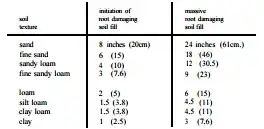
13. Approximate amount of soil removal, by texture class, that can be taken away before having
significant negative impacts on tree root health and growth. (These are highly variable values depending
upon compaction, aeration/drainage, native soil attributes, residual structure, removal method,
organic matter content, and other compounding soil / site problems.) All soil removal can mechanically
disrupt root tissue leading to acute and chronic problems that permanently damage the tree.
Judging the threshold of potential damage is a professional decision beginning with site management
objectives.
14.
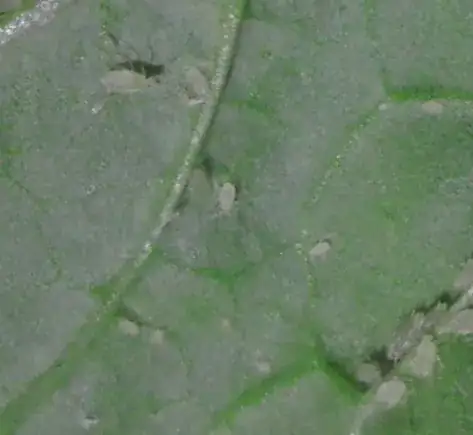
15. Construction damage to major branches is judged after the injuries have been properly cleaned-up
and a standard pruning cut is made. Only after the final pruning cut is completed can full branch damage be
assessed. Additional damage can occur after the construction injury as a result of improper pruning tools,
techniques, and skills. In this assessment system it is assumed that proper standard pruning practices will be
followed. Within standard pruning practices, heartwood and decay column exposure will be used to estimate
damage to the health and structure of the tree now, and into the future.
This assessment system provides a user with the maximum number of cuts per wound damage class
that should be made without significant and permanent damage to the tree. The basis of this system is examination
of the cross-section of the living base of any properly pruned branch. It is critical that assessors differentiate
between heartwood, sapwood, and chemically altered wood areas (decay, discoloration, and defensive
responses)
Types and number of branch pruning cuts remaining after the tree is cleaned-up from construction
damage (significant injury and liability risk exist in the damaged tree):
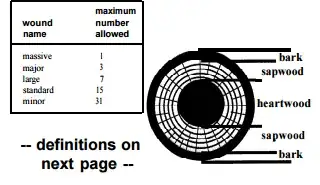
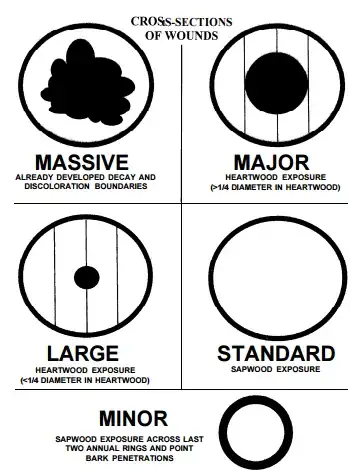
16. One of the most important aspects of assessing construction damage to trees is the amount of
time development activities occur on a site. Both the absolute time span and the timing of damage in
comparison to tree growth patterns are critical to assessing damage and estimating recovery times.
Use of a construction damage timing table is both a method of training new assessors and a means of
quantifying the potential extent of damage to trees.
This assessment process develops a “Tree Damage Exposure Value.” This Exposure Value is
determined by establishing a time-line for beginning and ending construction activities on a site.
Components of the Tree Damage Exposure Value include the number of different tree growth seasons
the construction activities have spanned, which season construction activities began within, which
season construction activities ended within, and how many full years have been involved in the construction
process.
Below is given an example time-line for calculating potential damage exposure timing for trees
on construction sites.
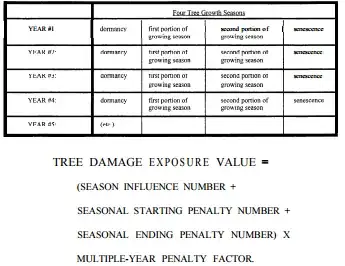
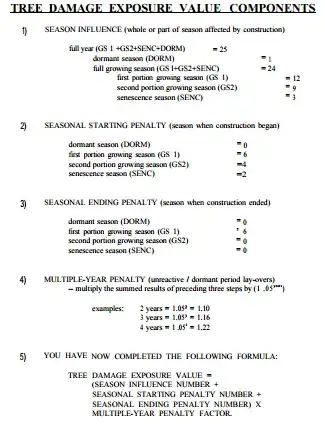
Calculated Tree Damage Exposure Values
To determine a Tree Damage Exposure Value, begin at the top of the table and identify when construction
activeties began on the site (by tree growth season). Next move downward in the appropriate starting column until you
reach the row representing the end of construction activities on the site. The number presented is the relative “Tree
Damage Exposure Value.” Abbreviations: DORM = dormancy season; GS 1 = first portion of growing season; GS2 =
second portion of growing season; SENC = senescence season.
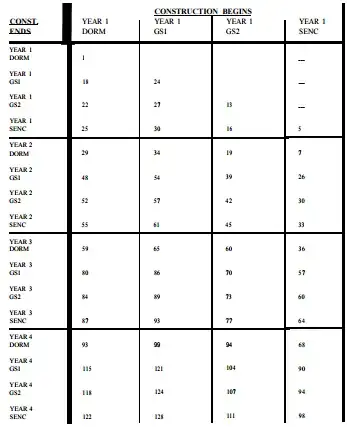
17. Once the construction damage exposure timer (TOOL # 16) has been used to determine relative
tree damage from construction activities, tree recovery times should be calculated. Recovery time
begins when construction activities end on a site. Landscape disruption and installation are the final
parts of construction on a site and can be extremely damaging, especially to any mature trees present.
When the last machinery has left the site, and the landscape and hardscape are completly installed,
recovery time can begin.
Recovery timing uses the same time-line and four seasons of tree growth as the construction
tree damage exposure value (TOOL #16). For each tree growth season affected by construction
activities, a specific length of recovery should be observed. From the moment of injury, the recovery
timing begins. Because of tree biology, recovery time periods are not additive, but run
CONCURRENTLY as each tree growth season is affected and grown past
